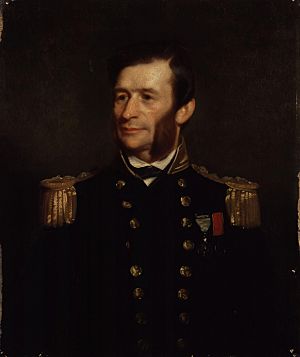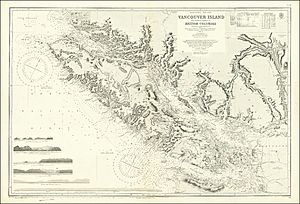George Henry Richards facts for kids
Quick facts for kids
Sir
George Henry Richards
|
|
|---|---|

1865 portrait of Richards
|
|
| Born | 13 January 1820 Antony, Cornwall, England |
| Died | 14 November 1896 (aged 76) Bath, Somerset, England |
| Allegiance | |
| Branch | |
| Service years | 1832–1896 |
| Rank | Admiral |
| Commands held |
|
| Wars | First Opium War |
Sir George Henry Richards (born January 13, 1820 – died November 14, 1896) was an important officer in the British Royal Navy. He was a hydrographer, which means he created detailed maps of the oceans and coastlines. From 1863 to 1874, he held the top job as the Hydrographer of the Royal Navy.
Contents
George Henry Richards was born in Antony, Cornwall, England. His father, Captain G. S. Richards, was also a naval officer. George joined the Royal Navy in 1832 when he was just 12 years old. His oldest son, George Edward Richards, also became a Royal Navy officer and a hydrographic surveyor.
Richards served in many different parts of the world during his naval career. He sailed to South America, the Falkland Islands, New Zealand, and Australia. He also took part in the First Opium War in China.
In 1854, he was promoted to the rank of captain. From 1857 to 1864, he commanded two important survey ships: HMS Plumper and HMS Hecate. These ships were used to explore and map coastlines and oceans.
Mapping the Canadian Coastline
From 1857 to 1862, Richards worked as a hydrographer along the coast of British Columbia in Canada. He was also a British representative for the San Juan Islands Boundary Commission. This commission helped decide the border between the United States and Canada.
Richards is famous for choosing and naming many places along the British Columbia coast. For example, in the Vancouver area, he named False Creek. In 1859, his engineer, Francis Brockton, found coal. Richards then named Brockton Point and the area of Coal Harbour. In 1860, he named Mount Garibaldi after a famous Italian general, Giuseppe Garibaldi. He also named the Britannia Range, Brunswick Mountain, and many other places in the Howe Sound, Sunshine Coast, and Jervis Inlet areas.
In 1863, Richards was given a very important job: Hydrographer to the Navy. He held this position until he retired in 1874. During this time, many merchant ships were sailing the seas, and underwater telegraph cables were being laid. This meant there was a great need for better and more accurate ocean maps.
Richards was asked to organize scientific voyages to create these maps. He led the cruises of the H.M.S. Porcupine and the H.M.S. Lightning between 1868 and 1870. After that, he organized the famous H.M.S. Challenger expedition, which explored the world's oceans.
Later Life and Achievements
In June 1866, Richards was elected a Fellow of the Royal Society. This is a very respected group of scientists. In the same year, he also became a member of the French Academy of Sciences.
He was knighted in 1877, which means he received the title "Sir." In 1881, he became a Knight Commander of the Order of the Bath, another high honor. He was promoted to the rank of admiral in 1884. Sir George Henry Richards passed away in Bath, Somerset, at the age of 76.
A painting of him by Stephen Pearce, made in 1865, can be seen at the National Portrait Gallery in London. Mount Richards in Waterton Lakes National Park in Alberta, Canada, is named in his honor.


